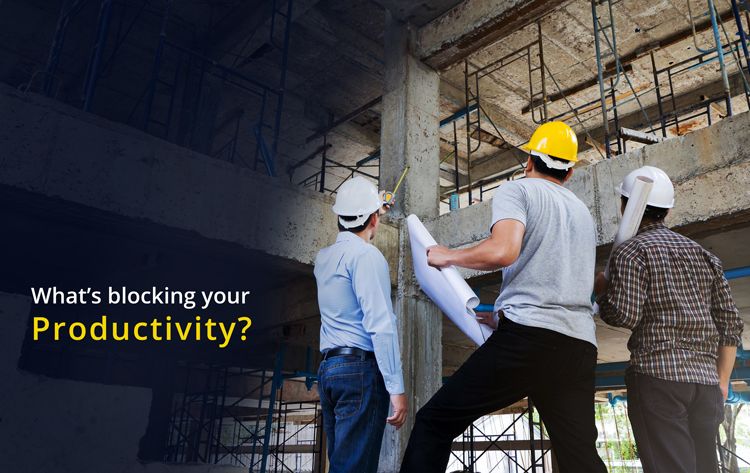In construction, productivity is the key to finishing the project on time and within budget. Yet, too often it’s equated with getting as much done in a day as is humanly possible, and far too many of us fall into that trap of cramming things into our day.
Compare that analogy with the dictionary definition; “the quality, state, or fact of being able to generate, create, enhance, or bring forth good and services,” and you’ll notice there is a difference. Productivity is getting the right things done, the right way, not getting as many things done as possible in dubious condition. Or, to use a cliché, productivity is quality over quantity.
In today’s industry, given current labor and economic conditions, everyone is trying to do more with less, yet still meet timelines and budgets. So, how do you get from cramming as much as possible into a day to concentrating on the right things and doing them well?
The first step to productivity is to identify and eliminate roadblocks that can distract you from priorities, turn your attention elsewhere and keep you in the “as much as possible” mode. Here are seven common roadblocks to look out for and banish from your jobsite.
Lack of planning
Lack of proper planning can lead to numerous issues and keep you in constant triage mode which is reactive, not proactive. Planning starts with preconstruction and developing formal processes that will strengthen your chances of minimizing costly, unexpected changes and lead to success. You’ll want to clarify the scope and schedule as well as define responsibilities. In addition, formalizing communication processes will ensure that information is relayed and communicated out in a timely manner. It seems intuitive; planning, creating processes and being organized can save you valuable time. But when you’re up against deadlines it’s easy to want to try to cut corners. By planning prior during preconstruction, you’ll be ready to handle challenges.
Not being organized
Lack of organization is a close cousin of planning, and directly affects your team’s time management. For example, is your team actively completing tasks or are they waiting around for material, searching for information, or looking for clarification? Help your team manage their time and set them up for success by being organized so that they can actually build.
Take 10-15 minutes at the end of the day planning what tomorrow and the next day look like. This will help make sure resources are allocated correctly when the day begins and no one is waiting on information or assignments. In addition, make sure tools and equipment are organized and ready for use. Review processes for use as well as checking them out and back in. Lastly, have a 5-minute standing information meeting, first thing, so everyone is clear on the tasks to be completed. Being organized saves valuable time and let’s your team get to work on what’s important faster.
Vague Priorities
With so many things going on at once, a construction project is complicated and it’s easy to miss the forest through the trees. This is further exasperated when priorities are unclear and there is a lack of context around tasks (why do I need to do it now?). It can lead to confusion, lack of follow through, and eventually errors. It is important to communicate and balance priorities to keep the project moving on schedule. Review and update them regularly to avoid any ambiguity on what needs to be accomplished.
Unclear Standards
Standards are the acceptable level of performance at the jobsite. Yet, each subcontractor has the potential to bring a different standard, perhaps one that doesn’t match yours. It’s here that a project can go awry and result in additional rework and schedule overruns.
By setting clear guidelines, in writing, of how tasks should be carried out, you set the standard for completion, including a clear, measureable process for verification. By setting standards you remove ambiguity on job performance and guarantee consistency.
Interpersonal conflicts
On the jobsite, communication and safety are important. But, conflicts amongst team members can not only put these at risk, they distract the team, erode trust and take valuable time to resolve. Your success is built on the quality of the people who work on your project. Look for a good fit for your team, which involves getting to know your team. Ask subs tough questions about their work and staff. Also, make clear that conflicts are not to be tolerated, and handle appropriately. When safety and productivity are affected, there is no room to keep a bad fit.
Technology challenges
With technology being used more and more on the jobsite, it’s important to choose platforms that teams will embrace. While technology improves and speeds up processes, not using the tool or using it incorrectly can cause errors, rework and stall productivity. Yet it’s challenging to find the perfect app because the comfort zone range with technology on the jobsite is broad.
If you’re looking for software for your team, look for an app that not only has all the features you need, but one that is easy and intuitive for everyone on the team to use. Don’t over complicate it. You don’t want excessive down time for training, or excessive unusable tools that looked good during the demo, but you’ll never use.
Also, considering hiring younger workers to manage technology for your business. Drones, BIM and VR can be an effective carrot to entice this tech savvy generation to the industry. Lastly, to facilitate technology adoption, make sure you equip your teams with the laptops and mobile devices critical to do the job.
Continuous improvement
The construction industry is suddenly changing at a quick pace. New technology, building materials, regulations, etc., all lend to an evolving industry that may seem hard to keep up with. Whether you’ve been in business twenty years or one year, make it a priority to stay on top of trends and continually educate yourself and your staff. Not keeping up-to-date can stall a project and negatively impact productivity. Continuous education will position you and your business for success now and in the future.
In today’s fast paced, “do more with less” environment, it seems productivity roadblocks are at every turn. But, with this list you can recognize and tackle them head on, and be on your way to getting the right things done, the right way.





